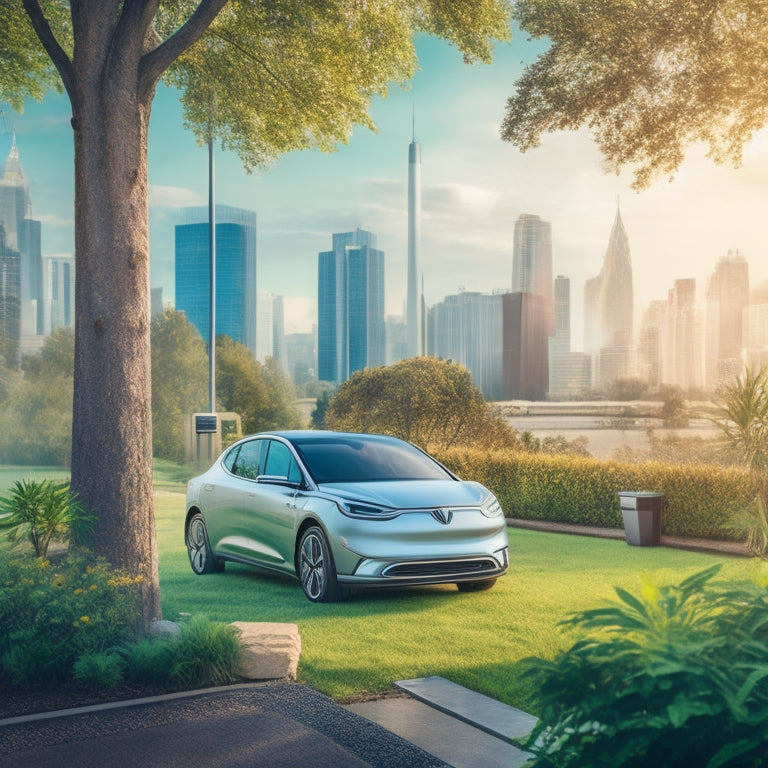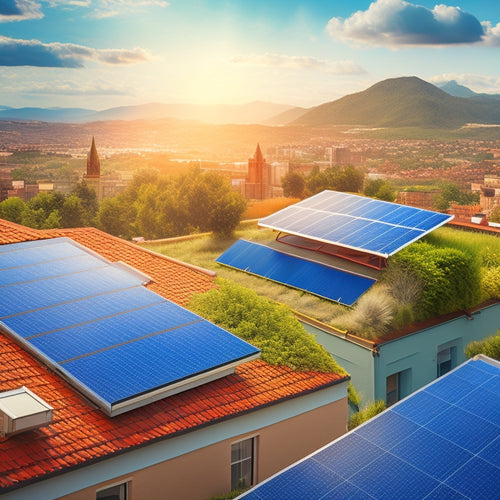
7 Best Practices for Energy-Efficient EV Charging
Share
By exploring energy-efficient practices, you can reduce the carbon footprint of Electric Vehicle (EV) charging infrastructure by up to 70%. To achieve this, you'll want to optimize charging station locations, select energy-efficient chargers, and implement smart charging systems. You should also leverage solar power integration, monitor and analyze energy usage, design for thermal efficiency, and establish regular maintenance schedules. By following these best practices, you'll not only reduce energy waste but also decrease the strain on the grid. Delve into the details to discover how each practice contributes to a more sustainable EV charging ecosystem.
Key Takeaways
• Place EV charging stations in high foot traffic areas, balancing land availability with zoning regulations for optimal urban planning.
• Select energy-efficient chargers with high ratings, made from materials like aluminum or copper, and certified by ENERGY STAR or UL.
• Implement smart charging systems that optimize charging times, reduce energy waste, and leverage Time of Use pricing for cost savings.
• Integrate solar power into EV charging systems to harness clean energy, reduce grid reliance, and maximize energy independence.
• Monitor and analyze energy usage patterns to optimize charging schedules, identify areas of inefficiency, and adjust to off-peak hours for grid relief.
Optimize Charging Station Location
By strategically positioning EV charging stations near areas of high foot traffic, such as shopping centers, restaurants, and entertainment venues, you can minimize the need for lengthy detours and reduce overall charging time. Effective urban planning is vital in identifying ideal locations that balance land availability with zoning regulations. This guarantees that charging stations are easily accessible while complying with local ordinances.
Additionally, integrating charging stations into parking strategies can maximize usage and encourage sustainable transportation. By optimizing charging station locations, you can increase adoption rates, reduce range anxiety, and promote a seamless charging experience. By doing so, you'll be supporting a more efficient and environmentally friendly transportation ecosystem.
Select Energy-Efficient Chargers
You can greatly reduce the carbon footprint of your EV charging infrastructure by selecting chargers with high energy efficiency ratings. These ratings are typically measured by their efficiency in converting AC power from the grid to DC power for the vehicle.
When choosing a charger, look for models made with energy-efficient materials, such as aluminum or copper. These materials can help reduce energy losses. Additionally, opt for chargers with certifications like ENERGY STAR or UL (Underwriters Laboratories). These certifications guarantee that the charger meets rigorous energy efficiency standards.
Implement Smart Charging Systems
Implementing smart charging systems can significantly reduce energy waste and strain on the grid. These systems optimize charging times based on factors like your vehicle's battery level, your schedule, and the grid's renewable energy availability. By leveraging Time of Use (TOU) pricing, you can charge your EV during off-peak hours when electricity rates are lower. This not only saves you money but also reduces the grid's peak demand.
Vehicle to Grid (V2G) technology enables your EV to act as an energy storage device, feeding excess energy back into the grid when not in use. This bi-directional energy flow can stabilize the grid and generate revenue for you.
Leverage Solar Power Integration
As you optimize your EV charging schedule, consider harnessing the power of solar energy to further reduce your carbon footprint and energy costs.
By integrating solar panels into your EV charging system, you can generate clean energy and reduce your reliance on the grid. This approach not only minimizes your environmental impact but also helps you save on energy costs.
With energy harvesting, you can store excess energy generated by your solar panels during the day and use it to charge your EV at night. This setup allows you to maximize your energy independence and reduce your energy bills.
Monitor and Analyze Energy Usage
Track your energy consumption patterns to identify areas of inefficiency, optimize your EV charging schedule, and make data-driven decisions to minimize energy waste.
By monitoring your energy usage, you can pinpoint opportunities to reduce consumption and optimize your charging habits.
Conduct regular energy audits to analyze your consumption patterns and identify areas for improvement. This data will enable you to adjust your charging schedule to off-peak hours, reducing strain on the grid and minimizing energy waste.
Design for Thermal Efficiency
By optimizing your EV charger's thermal design, you can reduce energy losses and increase the overall efficiency of your charging system. A well-designed thermal system helps to dissipate heat generated by the charger, reducing the risk of overheating and improving overall performance.
To achieve peak thermal efficiency, consider the following design strategies:
- Select heat sink materials with high thermal conductivity to efficiently dissipate heat.
- Implement active cooling system designs, such as fans or liquid cooling systems, to enhance heat dissipation.
- Optimize component placement to minimize thermal resistance and reduce heat buildup.
- Use thermal simulation tools to analyze and optimize your design before prototyping.
Ensure Regular Maintenance Schedules
To prolong the lifespan and efficiency of your EV charging system, you must establish a regular maintenance schedule that includes inspection and replacement of worn-out components, cleaning of dust and debris, and firmware updates. This guarantees your system operates within peak parameters, minimizing energy waste and reducing your carbon footprint.
| Maintenance Task | Frequency | Description |
| Inspect and clean charging connectors | Quarterly | Remove dirt and debris to guarantee secure connections |
| Check tire pressure | Monthly | Proper pressure improves efficiency and range |
| Battery calibration | Semiannually | Maintain peak battery health and performance |
| Firmware updates | As needed | Stay up-to-date with the latest software improvements |
Frequently Asked Questions
Can I Charge My EV in the Rain or Wet Conditions?
When charging your EV in the rain or wet conditions, you're safe as long as you use waterproof cables and guarantee proper grounding to avoid electrical shocks or grounding issues.
Are Energy-Efficient EV Chargers Compatible With All Vehicle Types?
You'll find that most energy-efficient EV chargers adhere to standardized connectors and protocols, ensuring compatibility with various vehicle types, as charger manufacturers prioritize Vehicle Adaptation to established Charger Standards for seamless integration.
Can I Install an EV Charger in My Apartment or Condominium?
You'll need to navigate Apartment Regulations and obtain Condo Approval before installing an EV charger in your apartment or condominium, ensuring compliance with local electric codes and potential homeowners' association rules.
How Do I Handle EV Charger Installation in Areas With High Winds?
When installing an EV charger in high-wind areas, you'll need to guarantee wind resistance by using reinforced mounts and seismic anchors to securely fasten the charger, preventing damage and ensuring safe operation.
Can I Sell Excess Energy Generated by My Solar Panels Back to the Grid?
"You're probably thinking, 'Will the utility company even allow me to sell back excess energy?' Fear not! With Net Metering, you can feed surplus energy into the grid, reaching Grid Parity, and even get credited for it - you're in control!"
Related Posts
-

Sustainable Scrubbing: Top Bathroom Solutions for Earth-Conscious Homes
You're taking an important step towards creating a more sustainable home by switching to eco-friendly bathroom cleani...
-

7 Solar-Safe Window Solutions for Earth-Conscious Homeowners
As an earth-conscious homeowner, you're likely keen to find solar-safe window solutions that align with your values. ...
-

What Roofing Materials Best Protect Our Planet?
As you consider the environmental impact of your building, you're likely to find that the roofing material you choose...


